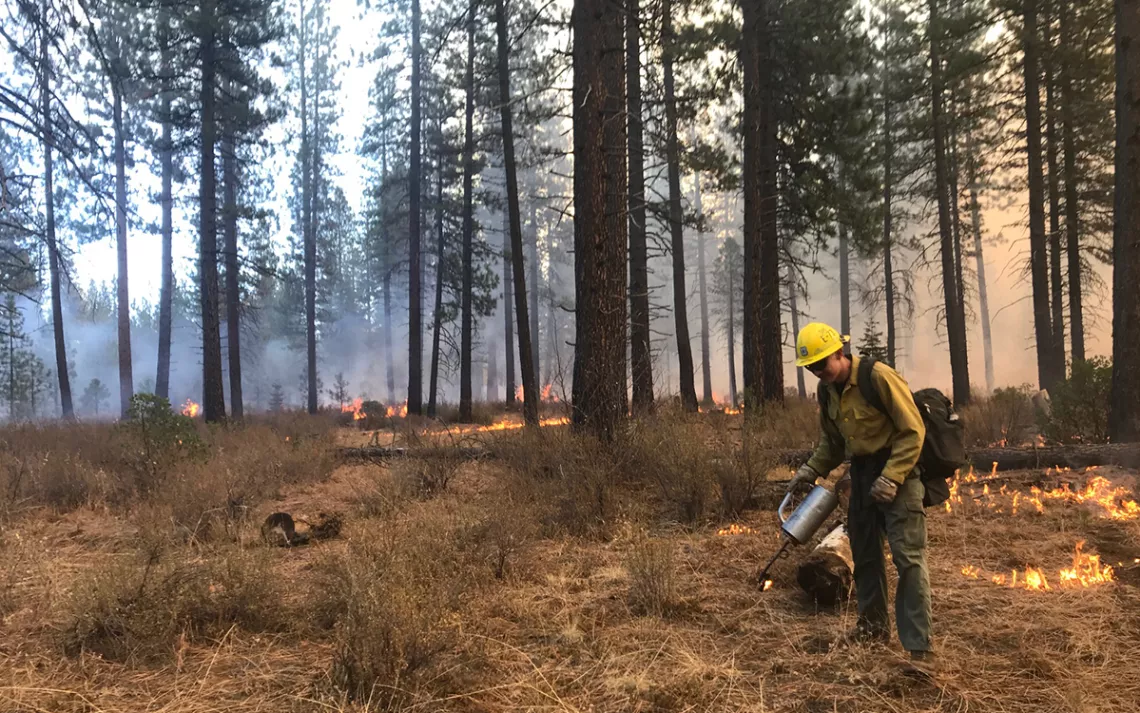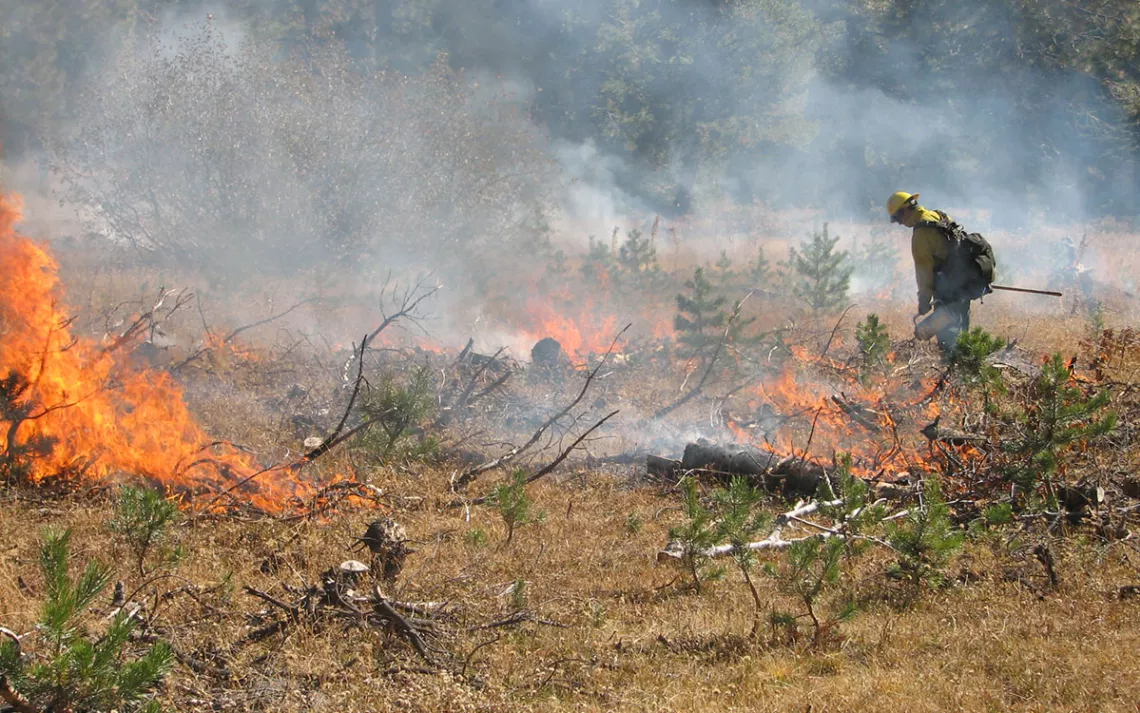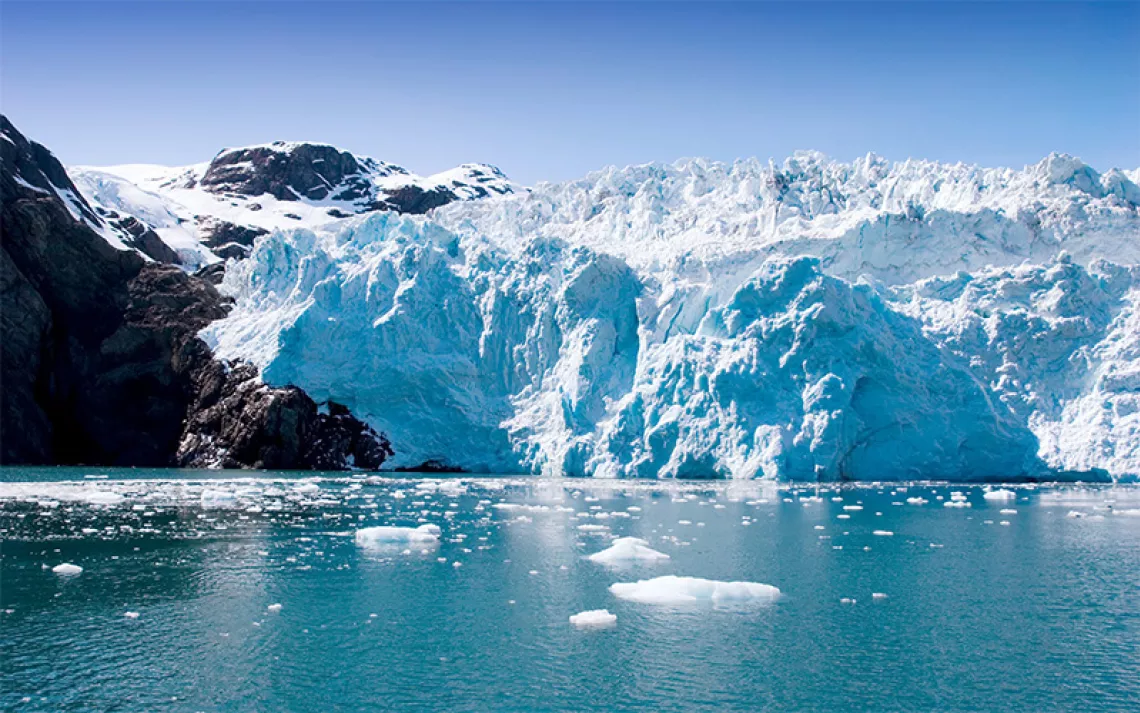California Needs More Fire
Why is it still so hard to start a prescribed fire in California?

Fire managers and firefighters carrying out an understory fire on October 12, 2018, in the Shasta-Trinity National Forest. | Photo by Liz Younger/US Forest Service
Baubles of fire drip from a fuel-loaded torch onto the forest floor. The woods fill with pops and crackles of fire consuming leaves and digesting them into smoke and ash. As grasses, twigs, and rotten logs disappear, so does their risk of becoming tinder for the kind of out-of-control, devastating wildfire that can kill healthy, mature trees, destroy homes, and blow a hole in global climate goals.
Controlled burns have arguably never had as much public support in the West as they do now. There’s widespread agreement among state and federal agencies, tribal leaders, and scientists that prescribed fire can help address out-of-control wildfires.
In May 2018, then-governor Jerry Brown set a goal of burning 500,000 acres of wildlands each year by 2023—a start at treating the 20 million acres that California’s Forest Carbon Plan estimates would benefit from prescribed fire or manual thinning. But just this past March, the state lowered that target to 400,000 acres per year by 2025, possibly because the actual acres burned each year were closer to a quarter of the new goal.
A month later, a burn conducted by the Forest Service in New Mexico got out of control, burned down hundreds of homes and displaced thousands. It was a devastating and unusual event—overall, the agency executes about 4,500 prescribed burns each year across the country. 99.84 percent of them go according to plan. (Across a larger group of agencies and burners in California, 98.24 percent of fires go according to plan.)
But it was also a worrisome sign. According to the Forest Service, the burn plan for the fire that got out of control complied with existing policy but underestimated how dry the vegetation in the area actually was—likely because of climate change.
In response, Forest Service chief Randy Moore paused all prescribed burns on Forest Service lands across the country until the end of the summer—a season when burns are less common but can take place with the right conditions. For over 100 days, a large swath of California was off-limits to prescribed fire.
In September, the Forest Service restarted prescribed burning with a report that reaffirmed the importance of intentional fire. “The agency needs to elevate prescribed burning,” said the report, adding that Forest Service employees spent too much time on administrative tasks as opposed to core duties, such as prescribed fire. By the end of this year, the agency aims to introduce a West Coast–based prescribed fire training program.
But the report’s new “recommendations and considerations” also make it even more complicated to plan a controlled burn. Prescribed fires now need to be reapproved every 24 hours, rather than during a longer burn window, with new analyses and paperwork required each time. Controlled burns rated as “moderate complexity” need more workers on site to gain approval. Any administrator who approves a high-complexity prescribed burn now needs to be on-site during the burn itself.

A controlled burn of Van Vleck Meadow in El Dorado National Forest. | Photo by Pacific Southwest Forest Service
For some, the new guidelines raise worries that the state is trading prescribed wildfire today for an out-of-control wildfire tomorrow. “Probably some projects won’t happen,” says Lenya Quinn-Davidson, director of the Northern California Prescribed Fire Council, of the new requirements. She doesn’t think the guidelines will make prescribed burns safer. Instead, “windows of opportunity will be missed because the right people aren’t in place to allow for it.”
Incentives to be cautious while carrying out controlled burns are strong. No one wants a prescribed fire to go astray, and federal agencies often punish prescribed fire escapes while failing to reward successful burns, according to a 2020 paper published in Nature Sustainability.
What is clear, according to the Nature Sustainability study, is that in California, “there is a notable gap between the acres planned for prescribed burning and the acres actually burned each year.”
But Quinn-Davidson also cautions against valuing the quantity of prescribed burns over the quality. Not all areas carry equivalent fire risk, and the complexity and impact of prescribed burn projects also need to be considered to target the most important areas to prevent extreme wildfire. Ultimately, “we’re all burning so little right now,” she says, “we’re not taking advantage of all of our burn windows.”
*
The practice of lighting strategic fires goes back thousands of years, to Indigenous tribes who used fire in nearly every part of the state to cultivate useful plant species in California’s forests and grasslands and reduce fire risk. That history makes the new Forest Service recommendations especially frustrating to some California tribes. The Karuk Tribe in Northern California, whose ancestral territory is largely managed by the Forest Service, had to scale back burning plans this year, says Bill Tripp, director of natural resources and environmental policy for the tribe.
“We had excellent burning windows in late June,” Tripp says. While the tribe was able to conduct successful burns on private property during that window, they had to steer clear of federal areas.
Tripp sees the new recommendations as the result of an agency culture of fear of liability. The Forest Service can get sued for approving a prescribed burn gone wrong, but, Tripp says, “nobody can get blamed for a wildfire.”
One sign that California is trying to make it easier to use managed fire is the state’s new $20 million liability fund for prescribed burns, signed into law in September. The fund addresses a gap in insurance for burns held on lands not owned by the government. If plans for the burn were approved by Cal Fire, and the burn itself was overseen by a state-certified burn boss or cultural practitioner, then the fund can help cover any damages inadvertently caused by a burn gone awry.
Tripp withdrew his support of the fund because the law requires that Cal Fire approve fire plans for cultural burners as well as burn bosses. “Claiming jurisdiction over cultural burning activities is not something that honors tribal sovereignty. We’re working to restore landscapes so we can revitalize our cultural burning practices.… Nobody is going to do ceremonial burning practices under the permission of the state.”
Tripp worries about losing the progress the Karuk Tribe has already made in keeping landscapes healthy. “A good portion of our territory has burned at least once in the past 20 years or so,” says Tripp. This means the land is closer to a natural fire regime of burns roughly every 10 years, he explains. Tripp worries that adding more administrative layers to controlled burns could “kick the can down the road … ultimately, you lose more homes, lives, and forests.”
Those delays could have terrifying consequences. A study from the University of Idaho found no significant increase in prescribed burn acreage in the western US from 1998 to 2018, despite the growing frequency and intensity of wildfires. “These big catastrophic wildfires, they’re a totally different beast, especially with some of this unprecedented weather we’ve seen,” says Emma McClure, a fire ecologist with the National Park Service’s Klamath Network.
There are other issues to overcome too, says McClure. Many agencies can’t maintain the staff needed to accomplish their prescribed burn goals. Seasonal firefighters may not work through fall, winter, and spring—prime seasons for prescribed burning. Those who do often make less money. “You don’t get hazard pay on a prescribed burn,” McClure points out.
*
Despite this, at the local level California has seen a rise in efforts around prescribed burning. Prescribed fire councils and community groups have been created across the state in the past decade. Some cities are taking matters into their own hands as well.
A few years ago, the City of Chico did very little prescribed burning, largely due to negative public perception. But 2018’s deadly Camp Fire in Paradise was a wakeup call for the nearby city and its residents, says Linda Herman, Chico’s park and natural resources manager. “[We’ve] seen how horrific forest fires can destroy California,” echoes Chris Zinko, the city’s deputy fire chief.
In response, the city launched a prescribed burn program in Bidwell Park, one of California’s largest municipal parks. While the community’s safety was the first priority of the prescribed fire program, the burns also made the park more enjoyable.
On a hike on the park’s trails, Herman can easily tell which areas haven’t had prescribed burns. They’re full of dry, brown vegetation and invasive star thistle—both of which could easily stoke a wildfire. As for the areas that have received prescribed burns? “Just as green as green can be,” says Herman.
 The Magazine of The Sierra Club
The Magazine of The Sierra Club



